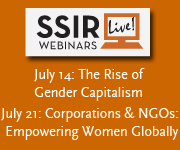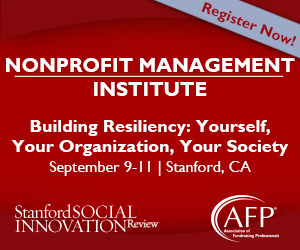ISSUE
Articles on social change from the latest edition of SSIR

Summer 2008
Volume 6, Number 3
In two articles about microfinance, the summer 2008 issue of Stanford Social Innovation Review covers how microfinance providers are funding the poverty-stricken while also creating revenue for investors, and envisioning a future where high volumes and not high margins provide a solid bottom line. This issue’s cover story, “Achieving Breakthrough Performance,” is devoted to the four simple but effective principles used by outstanding managers as they take their organizations into the rarefied realm of breakthrough performance and lasting change.
Features
Microloan Sharks
Commercial microfinance institutions (MFIs) must calculate two bottom lines: alleviating poverty for clients and also generating profits for investors. To achieve the latter goal, some MFIs charge their impoverished clients exorbitant interest rates. The recent Banco Compartamos IPO in Mexico raises a red flag, demonstrating how easily well-intentioned MFIs and their investors can shift from microlending to microloan-sharking.
The Equity Capital Gap
For-profit businesses can efficiently and quickly raise large amounts of money to fund growth and innovation by tapping equity capital—money that people invest in a company in return for ownership and a share of profits. The nonprofit world has no corollary, making it difficult, costly, and time-consuming to raise money. In this article the author explores ways that nonprofits and funders can create their own version of equity capital, and, just as important, develop an equity approach to doing business.
Reimagining Microfinance
Critics of microfinance institutions (MFIs) ask them to choose between helping the poor or making money for investors, but this is a false choice. MFIs can have their impact and profit, too, says the author, the CEO of the Grameen Foundation. He sketches a new vision of microfinance as a platform, not a product; one that relies on high volumes, not high margins, and that uses limits on private benefit, holistic performance standards, and third-party certification to help MFIs meet both their bottom lines.
Achieving Breakthrough Performance
From the Girl Scouts, to Partners In Health, to the city of Providence, R.I., great organizations have one thing in common: great managers. These managers, in turn, share four simple management principles that they use to guide organizations from mere mediocrity to stand-out stardom.
Field Report
Tackling HIV
Grassroot Soccer uses the world’s most popular sport to educate kids in sub-Saharan Africa about HIV and its prevention.
She’s Crafty
World of Good connects female artisans in poor countries with retailers (including Whole Foods Market, pictured) in the West.
From the Ground Up
Part academic institution, part activist group, part think tank, ATREE crosses sectors to breed a new species of conservation agency in India.
Books to Grow On
How did Room to Read create more than 5,000 libraries in less than eight years? The media have largely focused on founder John Wood as the catalytic figure in the organization's success story. Of equal importance, however, is Room to Read's solid and replicable operational choices.
Case Study
Taking Stock of Venture Philanthropy
In the early, heady days of the venture philanthropy movement, its proponents touted it as revolutionary, while critics said it was just old wine in new bottles. The experiences of the Center for Venture Philanthropy show that the truth lies somewhere in between: Venture philanthropy is no miracle cure, yet it can be particularly good at building strong organizations, knitting together new networks, and shrinking the power gap between funders and grantees.
Viewpoint
We’ve Arrived. Now What?
Although the donor-advised fund industry is in a high-growth phase, all boats will rise if we worry less about competing with each other and instead find ways to work together. By Kim Wright-Violich, president of Schwab Charitable.
Fast Food and the Family Farm
It’s time to reform how we grow food and what we have for dinner, says Bruce Boyd, principal and managing director at Arabella Philanthropic Investment Advisors.
Research
The Toughest Job You’ll Never Get
Would-be EDs cite inadequate mentoring, low pay, and poor lifestyle as career obstacles.
Smoke and Mirrors
British American Tobacco Malaysia has won the favor of the Malaysian government and people by making donations to cultural institutions, funding scholarships, and developing youth smoking prevention programs. But can a tobacco company ever be socially responsible?
A Lot of Hot Air
A popular Mexico City program for cutting air pollution from vehicles doesn’t work; in fact sales of new cars, used cars, and gasoline have climbed since the program's launch in 1989.
Books
Review: Creating a World Without Poverty
Nobel Peace Prize winner Mohammad Yunus aims for a more just society for all.
Q&A
15 Minutes with Martin Eakes
Managing Editor Eric Nee spoke with Self-Help’s founder and CEO, Martin Eakes, about the subprime loan crisis and its impact on the poor.
 → This form is for US/Canada subscribers. Are you an international subscriber?
→ This form is for US/Canada subscribers. Are you an international subscriber?
Click here instead.
Subscribe Now!
Subscribers get premium online access (articles with a key) including 9-year archive, downloadable digital edition, quarterly print issues (optional).





.jpg)



























































